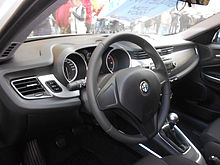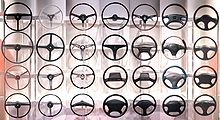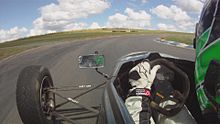- Steering wheel
-
This article is about steering wheels in cars. For the use in vessels, see Steering wheel (ship).
A steering wheel (also called a driving wheel or hand wheel) is a type of steering control in vehicles and vessels (ships and boats).
Steering wheels are used in most modern land vehicles, including all mass-production automobiles as well as light and heavy trucks. The steering wheel is the part of the steering system that is manipulated by the driver; the rest of the steering system responds to such driver inputs. This can be through direct mechanical contact as in recirculating ball or rack and pinion steering gears, without or with the assistance of hydraulic power steering, HPS, or as in some modern production cars with the assistance of computer controlled motors, known as Electric Power Steering. With the introduction of federal vehicle regulation in the United States in 1968, FMVSS 114 required the impairment of steering wheel rotation (or transmission locked in "park") to hinder motor vehicle theft; in most vehicles this is accomplished when the ignition key is removed from the ignition lock. See steering lock.
Contents
History
 Rigid steering column and wheel in a Packard from 1920s
Rigid steering column and wheel in a Packard from 1920s Steering wheel in a Chrysler Airflow from the 1930s
Steering wheel in a Chrysler Airflow from the 1930s
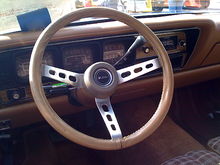 Steering wheel on a collapsible column in an AMC Matador from the 1970s
Steering wheel on a collapsible column in an AMC Matador from the 1970s
The first automobiles were steered with a tiller, but in 1894 Alfred Vacheron took part in the Paris-Rouen race with a Panhard 4 hp model which he had fitted with a steering wheel.[1] That is believed to be one of the earliest employments of the principle.[2]
From 1898 the Panhard et Levassor cars were equipped as standard with steering wheels. C S Rolls introduced the first car in Britain fitted with a steering wheel when he imported a 6 hp Panhard from France in 1898.[3] Arthur Constantin Krebs replaced the tiller with an inclined steering wheel for the Panhard car he designed for the Paris-Amsterdam race which ran 7–13 July 1898.[4]
In 1898, Thomas B. Jeffery and his son, Charles T. Jeffery, developed two advanced experimental cars featuring a front-mounted engine, as well as a steering wheel that was mounted on the left-hand side.[5] However, the early automaker adopted a more “conventional” rear-engine and tiller-steering layout for its first mass-produced Ramblers in 1902.[5] The following year, the Rambler Model E was largely unchanged, except that it came equipped with a tiller early in the year, but with a steering wheel by the end of 1903.[6] By 1904, all Ramblers featured steering wheels.[7] Within a decade, the steering wheel had entirely replaced the tiller in automobiles. At the insistence of Thomas B. Jeffery, the position of the driver was also moved to the left-hand side of the car during the 1903 Rambler production.[8] Most other car makers began offering cars with left-hand drive in 1910.[9] Soon after, most cars in the U.S. converted to left hand drive.[10]
Passenger cars
Steering wheels for passenger automobiles are generally circular, and are mounted to the steering column by a hub connected to the outer ring of the steering wheel by one or more spokes (single spoke wheels being a rather rare exception). Other types of vehicles may use the circular design, a butterfly shape, or some other shape. In countries where cars must drive on the left side of the road, the steering wheel is typically on the right side of the car (right-hand drive or RHD); the converse applies in countries where cars drive on the right side of the road (left-hand drive or LHD).
In addition to its use in steering, the steering wheel is the usual location for a button to activate the car's horn. Modern automobiles may have other controls, such as cruise control and audio system controls built into the steering wheel to minimize the extent to which the driver must take their hands off the wheel.
The steering wheels were rigid and mounted on non-collapsible steering columns. This arrangement increased the risk of impaling the driver in case of a severe crash. The first collapsible steering column was invented in 1934 but was never successful marketed.[11] In 1968, United States regulations (FMVSS Standard No. 204) were implemented concerning the acceptable rearward movement of the steering wheel in case of crash.[12] Collapsible steering columns were required to meet that standard.
Power steering gives the driver an easier means by which the steering of a car can be accomplished. Modern power steering has almost universally relied on a hydraulic system, although electrical systems are steadily replacing this technology. Mechanical power steering systems (e.g., Studebaker, 1952) have been invented, but their weight and complexity negate the benefits that they provide.
While other methods of steering passenger cars have resulted from experiments, for example the "wrist-twist instant steering" Mercury Park Lanes controlled by two 5-inch (127 mm) rings,[13] none have yet been deployed as successfully as the conventional large steering wheel.
Other designs
The steering wheel is centrally located on certain high-performance sports cars, such as the McLaren F1, and in the majority of single-seat racing cars.
As a driver may have his hands on the steering wheel for hours at a time these are designed with ergonomics in mind. However, the most important concern is that the driver can effectively convey torque to the steering system; this is especially important in vehicles without power steering or in the rare event of a loss of steering assist. A typical design for circular steering wheels is a steel or magnesium rim with a plastic or rubberized grip molded over and around it. Some drivers purchase vinyl or textile steering wheel covers to enhance grip or comfort, or simply as decoration. Another device used to make steering easier is the brodie knob.
A similar device in aircraft is the yoke. Water vessels not steered from a stern-mounted tiller are directed with the ship's wheel, which may have inspired the concept of the steering wheel.
Early Formula One cars used steering wheels taken directly from road cars. They were normally made from wood (necessitating the use of driving gloves), and in the absence of packaging constraints they tended to be made as large a diameter as possible, to reduce the effort needed to turn. As cars grew progressively lower and cockpits narrower throughout the 1960s and 1970s, steering wheels became smaller, so as to fit into the more compact space available.[14]
Spokes in steering wheel
The number of spokes in the steering wheel has continuously changed. Most early cars had four-spoke steering wheels.[15]
A Banjo Steering Wheel was an option on many early automobiles. Banjo Wheels predate power steering. The wire spokes were a buffer or absorber between the driver's hands and the drum of the road. Most were 3 or 4 spokes made of four or five wires in each spoke, hence the name "Banjo".
Adjustable steering wheels
Tilt Wheel
The original Tilt Wheel was developed by Edward James Lobdell in the early 1900s. The seven position Tilt Wheel was made available in several General Motors products in 1963. Originally a luxury option on cars, the tilt function helps to adjust the steering wheel by moving the wheel through an arc in an up and down motion. Tilt Steering Wheels rely upon a ratchet joint located in the steering column just below the steering wheel. By disengaging the ratchet lock, the wheel can be adjusted upward or downward while the steering column remains stationary below the joint. Some designs place the pivot slightly forward along the column, allowing for a fair amount of vertical movement of the steering wheel with little actual tilt, while other designs place the pivot almost inside the steering wheel, allowing adjustment of the angle of the steering wheel with almost no change it its height.Telescope Wheel
Developed by General Motors Saginaw Steering Gear Division (now Nexteer Automotive), the telescoping wheel can be adjusted to an infinite number of positions in a 3-inch range. The Tilt and Telescope steering wheel was introduced as an exclusive option on Cadillac automobiles in 1965.Adjustable Steering Column
In contrast, an adjustable steering column allows steering wheel height to be adjusted with only a small, useful change in tilt. Most of these systems work with compression locks or electric motors instead of ratchet mechanisms; the latter may be capable of moving to a memorized position when a given driver uses the car, or of moving up and forward for entry or exit.Swing-away Steering Wheel
Introduced on the 1961 Ford Thunderbird, and made available on other Ford products throughout the 1960s, the Swing-away steering wheel allowed the steering wheel to move nine inches to the right when the transmission selector was in Park, so as to make driver exit and entry easier.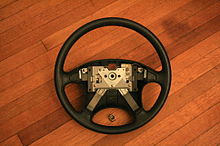 A steering wheel with the airbag module removed
A steering wheel with the airbag module removed
Usage
The steering wheel should be used with strategic movements of the hand and wrist in spinning motions. Caution and care should be used to ensure safety of the extremities. The constant motions used must be performed with caution. "Proper posture of the hand-arm system while using hand tools is very important. As a rule the wrist should not be bent, but must be kept straight to avoid overexertion of such tissues as tendons and tendon sheaths and compression of nerves and blood vessels."[16]
The act of turning the steering wheel while the vehicle is stationary is called dry steering. It is generally advised to avoid dry steering as it puts strain on the steering mechanism and causes undue wear of the tires.
Buttons and controls on the steering wheel
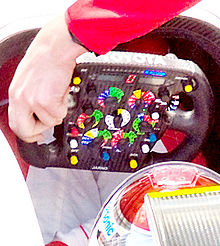 A modern Formula One car's steering wheel has buttons and knobs to control various functions as well as gauges and other important items normally found on a dashboard.
A modern Formula One car's steering wheel has buttons and knobs to control various functions as well as gauges and other important items normally found on a dashboard.
The first button added to the steering wheel was a switch to activate the car's electric horn. Traditionally located on the steering wheel hub or center pad, the horn switch was sometimes placed on the spokes or activated via a decorative horn ring which obviated the necessity to move a hand away from the rim. A further development, the Rim Blow steering wheel, integrated the horn switch into the steering wheel rim itself.
When speed control systems were introduced in the 1960s, some automakers located the operating switches for this feature on the steering wheel. In the 1990s, a proliferation of new buttons began to appear on automobile steering wheels. Remote or alternate adjustments for the audio system, the telephone and voice control, acoustic repetition of the last navigation instruction, stereo system, and on board computer functions can be operated comfortably and safely using buttons on the steering wheel. This ensures a high standard of additional safety since the driver is able in this way to control and operate many systems without even taking hands off the wheel or eyes off the road.
The scroll buttons can be used to set volume levels or page through menus.
Steering wheel audio control can use universal interfaces,[17][18] wired or wirelessly.
The buttons can be adjusted manually for reach and height.
Gaming imitations
Main article: Video game controller#Steering wheelCertain game controllers available for arcade cabinets, personal computers and console games are designed to look and feel like a steering wheel and intended for use in racing games. The cheapest ones are just paddle controllers with a larger wheel, but most today's examples employ force feedback to simulate the tactile feedback a real driver feels from a steering wheel. This contributes to steering "feel" and is one of the hallmarks of a true "driver's car" or sports car.
See also
- Steering wheel (ship)
- Dry steering
- Remote control
- Traffic directionality
Notes
- ^ Greathouse, John (2008). "Reinvent The Wheel – A Nonstandard Look at Standards". infoChachkie. http://www.infochachkie.com/wheel/. Retrieved 2011-01-04.
- ^ Duncan, H.O. (1927). The World on Wheels - Volume I. Paris. pp. 456–457, picture of the Vacheron-Car on p. 457.
- ^ "C S Rolls sitting in the first car in Britain fitted with wheel steering, 1898". Science & Society Picture Library. http://www.scienceandsociety.co.uk/results.asp?image=10318524&wwwflag=2&imagepos=13. Retrieved 2011-01-04.
- ^ [1][dead link]
- ^ a b Binder, Al; the Ward's staff (2003-12-01). "Rear View Mirror". Ward's AutoWorld. http://wardsautoworld.com/ar/auto_rear_view_mirror_16/index.html. Retrieved 2011-01-04.
- ^ Hyde, Charles K. (2009). Storied Independent Automakers: Nash, Hudson, and American Motors. Wayne State University Press. p. 12. ISBN 9780814334461. http://books.google.com/books?id=PerGbKxOPZYC&pg=PA12&dq=history+Steering+wheel+Rambler. Retrieved 2011-01-04.
- ^ "The Swift Rambler Family". The World's Work 8: 5218–9. 1904. http://books.google.com/books?id=AYbNAAAAMAAJ&pg=PA5218-IA38&dq=history+Steering+wheel+Rambler. Retrieved 2011-01-04.
- ^ Gottlieb, Robert J.. "Nash 600 coupe". Motor Trend 29: 109. http://books.google.com/books?id=ZJI9AQAAIAAJ&q=replaced+by+a+steering+wheel+and+the+driver+was+moved+to+the+left-+hand+side+of+the. Retrieved 2011-01-04.
- ^ Madden, W. C. (2002). Haynes-Apperson and America's first practical automobile: a history. McFarland. p. 56. ISBN 9780786413973. http://books.google.com/books?id=L3ooSQxwGwUC&pg=PA56&dq=Most+US+cars+convert+to+lefthand+drive. Retrieved 5 January 2011.
- ^ Oldham, Scott; Lamm, Michael (May 1996). "Happy 100th!". Popular Mechanics 173 (5): 49. http://books.google.com/books?id=MWUEAAAAMBAJ&pg=PA49&dq=Most+US+cars+convert+to+lefthand+drive. Retrieved 5 January 2011.
- ^ "Steering Wheel Folds In Crash" Popular Science, November 1934, article bottom of page 32
- ^ "Federal Motor Vehicle Safety Standards and Regulations". Nhtsa.dot.gov. http://www.nhtsa.dot.gov/cars/rules/import/FMVSS/#SN204. Retrieved 2009-12-08.[dead link]
- ^ Markovich, Alex (April 1965). "Look, Ma-No Wheels". Popular Mechanics 123 (4): 91–93. http://books.google.com/books?id=A-MDAAAAMBAJ&pg=PA91&dq=Mercury+twist+wrist+steering. Retrieved 2011–01–05.
- ^ Formula One [2] retrieved on 02/01/2011
- ^ Porázik, Juraj; Oravec, Ján (1985). Old time classic cars, 1885-1940. Arco Publishing. p. 9780668063074. ISBN 9780668063074. http://books.google.com/books?id=qWI0V6q6SwwC&q=Controls+on+the+steering+wheel+of+early+cars. Retrieved 5 January 2011.
- ^ Kroemer, K. (2001). Ergonomics. Englewood Cliffs: Prentice Hall. ISBN 0137524781.
- ^ "Universal steering wheel audio control interface". Tradekey.com. 2009-04-15. http://www.tradekey.com/selloffer_view/id/121556.htm. Retrieved 2009-12-08.
- ^ "DIY for Steering Wheel Removal and Steering Wheel Audio Control Unit Install - Page 6 - MY350Z.COM Forums". My350z.com. http://my350z.com/forum/body-interior-exterior-and-lighting-diy/77855-diy-for-steering-wheel-removal-and-steering-wheel-audio-control-unit-install-6.html. Retrieved 2009-12-08.
Categories:- Human–machine interaction
- Auto parts
- Control devices
- 1899 introductions
Wikimedia Foundation. 2010.

